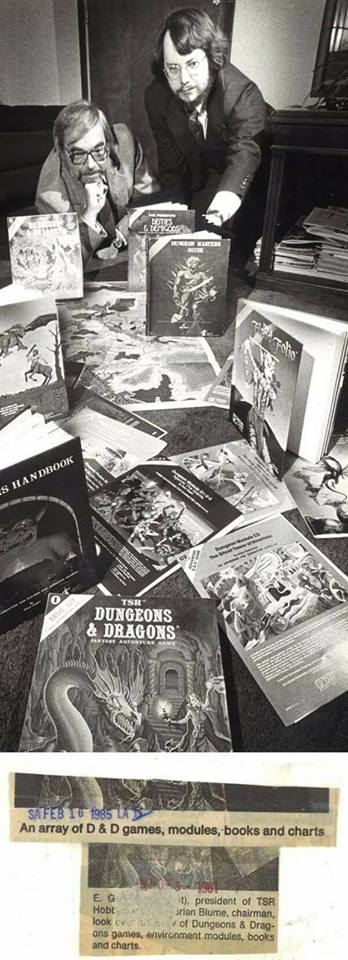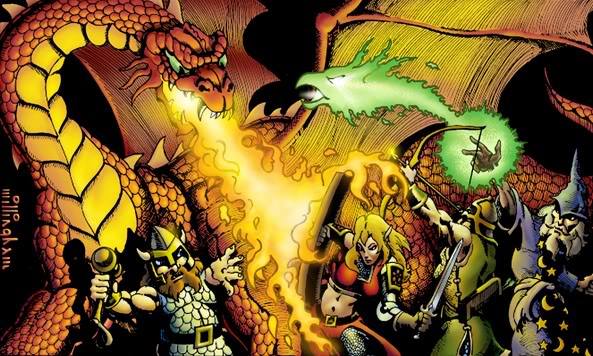

The whole of ADVANCED
DUNGEONS & DRAGONS was a protect which involved varying degrees
of my
thought, imagination, and actual working
time a period
of more than a year and one-half. Because of other
demands, the project was perforce set
aside for a day or a week or even longer, making it hard to get back to.
Knowing
that this would be the case when I began,
the MONSTER MANUAL was selected as the
1st of the 3 volumes in the
advanced game to work
-- hundreds of different creatures lend themselves to segmental treatment.
Only after
that book was finished did I begin to
put the sheaved reams of notes for the Players and Dungeon Masters
books into order, and that only as the
bones - tables, charts and matrices - for rough typing and careful rechecking
before
a final manuscript was built around them.
This latter part of the ADVANCED
DUNGEONS & DRAGONS project I approached with no small amount
of
trepidation. After all, the game‘s major
appeal is to those persons with unusually active imagination and
superior, active intellect - a very demanding
audience indeed. Furthermore, a great majority of readers master their
own
dungeons and are necessarily creative
- the most critical audience of all! Authoring these works means that,
in
a way, I have set myself up as final arbiter
of fantasy role playing in the minds of the majority of D&D
adventurers.
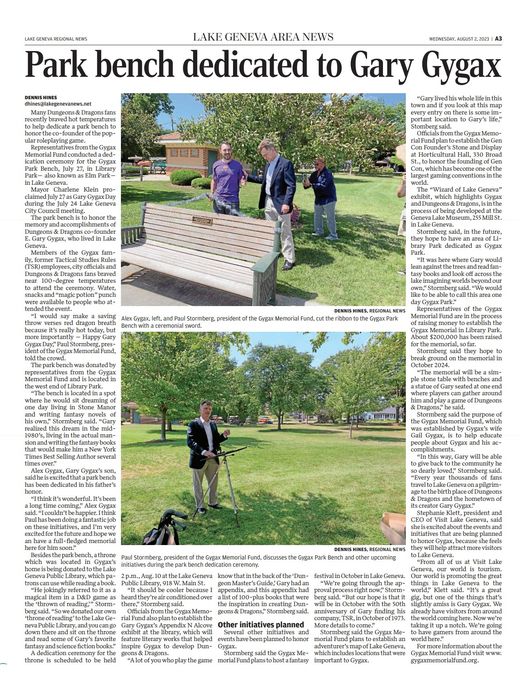
Well, so be it, I rationalized. Who better
than the individual responsible for it all as creator of the ”Fantasy Supplement”
in CHAINMAIL, the progenitor of D&D;
and as the first proponent of fantasy gaming and a principal in
TSR, the company one thinks of when fantasy
games are mentioned, the credit and blame rests ultimately here.
Some last authority must be established
for a very good reason.
There is a need for a certain amount of
uniformity from campaign to campaign in D&D.
This is not to say that conformity or
sameness is desirable. Nobody wishes to have stale campaigns where dungeons,
monsters,
traps, tricks, and goals are much the
same as those encountered in any one of a score of other campaigns.
Uniformity means that classes are relatively
the same in abilities and approach to solving the problems with which the
campaign confronts them. Uniformity means
that treasure and experience are near a reasonable mean.
Uniformity means that the campaign is
neither a give-away show nor a killer - that rewards are just that, and
great risk will
produce commensurate rewards, that intelligent
play will give characters a fighting chance of survival.
No individual can actually dictate the
actual operations of a campaign, however, for that is the prerogative of
the
Dungeon Master, first and foremost, and
to the players in the individual campaign thereafter. In like manner,
players greatly influence the events of
each particular campaign, and they must accept a large portion of blame
if it is a
poor game, and if the campaign is outstanding,
they deserve high praise for helping to shape the game and playing
well.
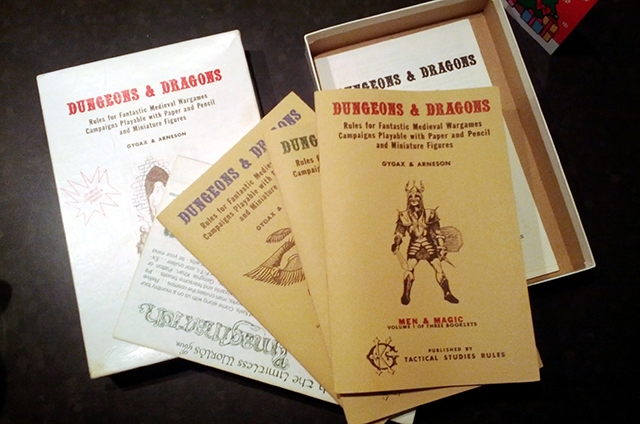
So at best I give you parameters here,
and the rest is up to the individuals who are the stuff D&D is made
of.
Naturally, every attempt has been made
to provide all of the truly essential information necessary for the game:
the skeleton and muscle which each DM
will flesh out to create the unique campaign. You will find no pretentious
dictums herein, no baseless limits arbitrarily
placed on female strength or male charisma, no ponderous
combat systems for greater "realism",
there isn't a hint of a spell point system whose record keeping would warm
the
heart of a monomaniacal statistics lover,
or anything else of the sort. You will find material which enables the
Dungeon
Master to conduct a campaign which is
challenging, where the unexpected is the order of the day, and much of
what takes place has meaning and reason
within the framework of the game "world".
It is important to keep in mind that, after
all is said and done, ADVANCED DUNGEONS & DRAGONS is a
game. Because it is a game, certain things
which seem "unrealistic" or simply unnecessary are integral to the system.
Classes have restrictions in order to
give a varied and unique approach to each class when they play, as well
as to provide play balance. Races are
given advantages or limits mainly because the whole character of the game
would be drastically altered if it were
otherwise. Everything in the ADVANCED DUNGEONS & DRAGONS system
has purpose; most of what is found herein
is essential to the campaign, and those sections which are not - such as
subclasses of characters, psionics, and
similar material - are clearly labeled as optional for inclusion.
What is here is, hopefully, presented in
as logical a sequence as possible, clearly, understandably, and with as
few ambiguities as could be managed. Many
readers will want more material. There is a wealth of commercial and
fan material available for fulfilling
such needs. Similarly, even the most important material herein can be altered
and
bent to suit the needs of individual campaigns.
Where possible, true _______guidelines_______ have been laid down to provide
the barest of frameworks for those areas
of the campaign which should be the most unusual and unique. Read the
work (or both works if you are a DM) through
and assess for yourself what ADVANCED D&D really is.
convinced that it does for the old D&D
+ supplements what GREYHAWK
did for D&D when it first appeared,
and then some. I
have put into these works what should
be the important parts of a superior D&D
campaign, cutting out material which
actually adds little or nothing to The
Game, revising the old, and adding and expanding in the essential areas.
Special thanks are due
to the following persons who contributed to the original game or have been
so kind as
to give their comments, criticism, and
contributions to this game:
Also thanks to Judges Guild, whose suggestions have helped with this work, and whose products have helped D&D.


David Lance Arneson
(October 1, 1947
- April 7, 2009)
- Grognardia (Gone But Not Forgotten)
DL Arneson was the
original author of the Assassin and Monk
classes.
Note that many or
all of the monsters in BLACKMOOR
were the work of Steve Marsh.
As well, note that
Tim Kask (who was involved in the early technical work of compiling AD&D)
is said to be the actual author of BLACKMOOR,
in the sense of
melding everything into publishable form.
- Pres
>
Handy Haversack wrote:
Hi Gary,
I was doing a bit of inspirational reading in the preface to the AD&D PHB last night and noticed that you thanked one Dennis Sustare. I was wondering if you could tell us who this fellow was, in terms of his connection to D&D, and whether he granted his name to the seventh-level druid spell Chariot of Sustarre. Thanks.
Michael

Sure:)
Dennis sent in the material that was used to make the druid a class rather than a sort of evil human monster as it had been in the OD&D game. The spell in question was ondeed named in his honor.
Cheers,
Gary

Joe Maccarrone wrote:
...
Whenever I start monkeying
with AD&D systems for the sake of streamlining or simplifying, I find
that AD&D is so ingrained that when I try to make a change, I may as
well be asking myself to think in centimeters! A method is only 'simpler'
or more logical if it springs to mind naturally...and after the past 25
years with AD&D, well..... ![]()

How well I know! I changed
all the game patois for the Lejendary Adventure system because it is different,
and I wished to force all those picking it up to alter their thinking,
so as to be able to more quickly and easily grasp the differences. Yet
I still find myself using AD&D terminology from force of habit.
The AD&D mechanics were
all meshed as are gears in a clock. The LA game parts are as closely intertwined,
but as the design is for a multi-genre system, many parts of the rules
have more tolerance for "adaptation"![]()
Cheers,
Gary

Yorlum wrote:
A question for the Master:
I am in the ongoing process of introducing my children to one of the joys of my own youth, AD&D. In doing so, I occasionally run into stumbling blocks when I try to describe character classes. Would you be willing to list out a person or character that leaps to your mind for each of the character classes and races?
I had a terrible time explaining that the elves were not toymakers, what a 'Cleric' is, etc.

Actually, yes I would have
a problem with that ![]()
The main difficulty is that some of the archetypes assume a reasonably broad knowledge of literature and films. Of course one might point to Ropbin Hood as a ranger, and the Sheriff of Nottingham as a fighter, Friar Fuck as a model for a cleric (although no spell use or undead turning are evident), and then go to Arthurian legend for Merlin as a magic-user, Galihad as a paladin. there are no ready models of a thief, druid, assassin, or monk.
You could use Bilbo, the
dwarves, Gandalf, and the rest from The Hobbit as examples.
John Bellairs Face in the
Frost supplies excellent examples of magic-users with one a near cleric
model IMO.
I do hope that helps a bit.
Cheers,
Gary

May I ask you something
about the transition between D&D and AD&D? I've often found that
the simple form and flavour of D&D is more to my tastes than the advanced
game, but that there are instances where I'll refer to tables and rules
in AD&D for clarifications or rules extensions where I think I need
them. Reading the AD&D DMG, that book seems almost written as an extension
of the original game rather than as a seperate game.
Was it always the intention that AD&D was going to be a seperate game, or did you originally envisage a more 'pick and choose' extension to the original game?

Short answer in regards
to AD&D. It was written as a separate game. I put part of the new system
into a D&D rewrite, though, as the latter was taking place even as
I was drafting the PHB.
Cheers,
Gary
richardstincer wrote:
Gary Gygax
Are all of the early ADandD 1st edit. info. rule sourcebooks from 1977, 1978, and 1979 compatible with later printings of those same books--starting with may 1985 and after? I mean the PHB, DMG, MM, Manual of the Planes, DLA, and other such stiff cardboard-cover books.

After 1986 cane 3E which
was not compatable with OAD&D, as there were many chenges of the sort
I would cite as unnecessary and arbitrary.
So the answer is no if you are referring to 2E books.
Cheers,
Gary

Clangador wrote:
Col_Pladoh wrote:
You know what I thnk about
PC thinking and speech ![]()
Cheers,
Gary

Well, anyone who has played
AD&D (1e) knows that you are not into PC thinking. ![]()
Back in 1978 when I was
writing the DMG there was no PC police, and I don't recall the term being
in existance ![]()
Cheers,
Gary

Quote:
- LA & AD&D. Just
curious how long it took you to complete each system? Just a rough estimate
if you can say, also which of all the game systems was pretty tough to
complete? If I remember the amount of information in Dangerous Journeys...and
the stupid legal battles. It was finished though right? I never looked
into it unfortunately.

The three core rules books
for the AD&D game took me about two and a half years to write.
During that period I also
wrote the G and D series of modules.
The World of Greyhawk map
and text took me about a month to write.
I spent about three and a half years on the LA game system's three cors rules books.
The DJ Mythus rules took
about the same amount of time, even with Dave NEwton's assistance.
Research of the material
that went into the Epic of AErth took over a year.

1. There is no relationship
between 3E and original D&D, or OAD&D for that matter.
Different games, style,
and spirit.
3. Off the top of my head,
and in no particular order, my favorite artists are Trampier, Elmore, Parkinson,
and Easley.
Hmmm... I think I am forgetting
someone here, but such is life.
As for why, well, that's
like asking why I like quail with artichoke sauce--a matter of taste
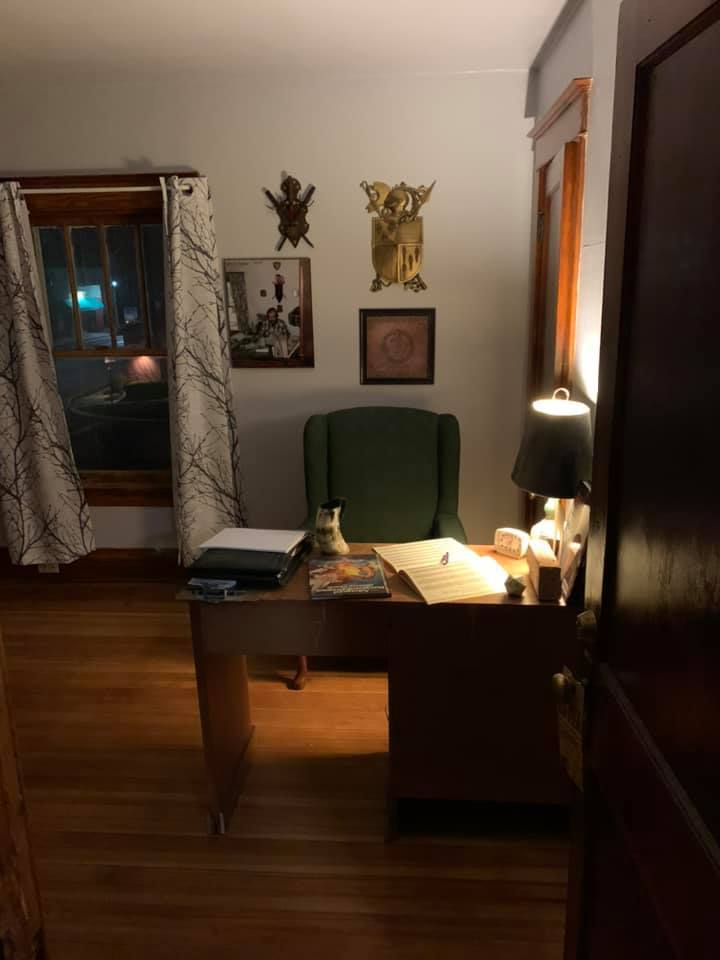
Quote:
Originally posted by Sir
Edgar
Can you talk more about
the style and spirit of D&D and AD&D during the 70's and 80's,
especially during conventions and such? What were your favorite moments
and what did you enjoy most about the atmosphere then? How was playing
and creating for D&D different from how it is ?

I could spend a good bit
of time doing that, speaking to the difference in style and spirit, but
that's a pale exercise. The only way one can really grasp the difference
is to play each game.
The main differences in the older works I did and 3E are style of writing, reliance on archetypes, limitatations on character advancement, availability of and creation of magic items, and general single-class play for human characters.
Play is mainly reliant on rules. I ignored those I write when DMing if the game called for that, and in all added what was logical in terms of the game environment to play. Thus much of adventuring was not "by the book," but rather seat of the pants play by DM and players alike.
Rules lawyers are unmentionable...
Creating adventures is something
that generally relies a lot on the system bases, rules, monsters, eivironments,
etc.
In regards to the first
named, the more rules one must pay close attention to, the more difficult
it is to create adventure material.
Gary

![]()
Quote:
Originally posted by
Larcen
2) How do you pronounce
Gygax, Ioun, Iuz, Tarrasque, Lich, and Tiamat? I pronounce them GUY-gax,
Yoon, Yuz, tar-ASK, litch, and TEE-a-matt.

2. GUY-gax is how my family
pronounces the name, but in proper Swiss it is pronounced GHE-gox.
As for Ioun, I say Eeun
but Yoon sounds fine,
and so too Eeuse, but Yuz
is okay,
We almost agree on the pronunciation
of Terrasque--err-ASK TO YOUR tar-ASK,
WE HARMONIZE ON litch (many
prefer lick),
and Tiamat as TEE-a-matt.
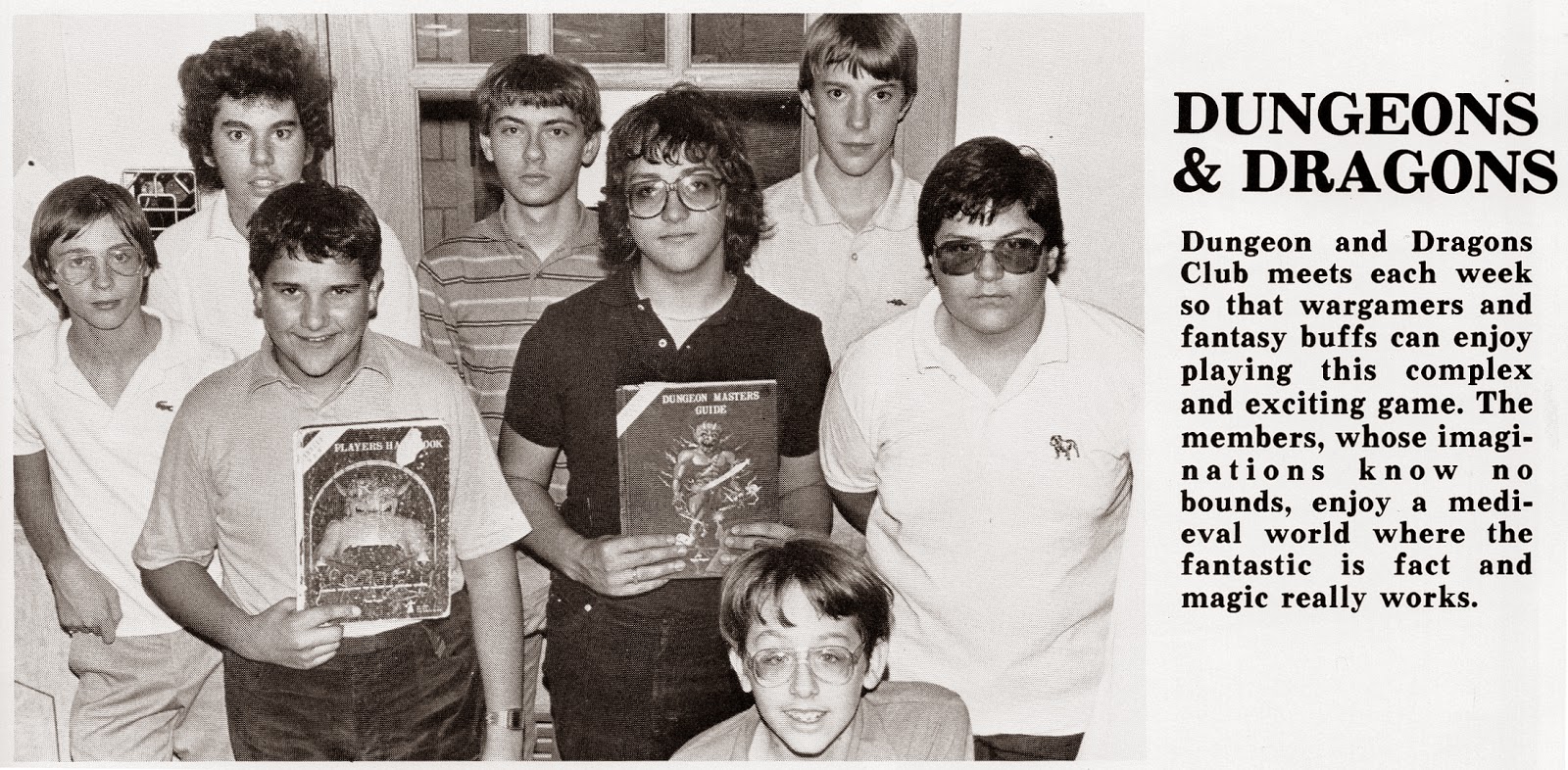

James
M: Gary Gygax thanks you in both the AD&D Players Handbook and
Dungeon Masters Guide.
What role did you play
in the development of these two books or indeed the entire AD&D project?
TIm Kask: Continuing in the same vein as the answer to the previous question, we constantly bounced ideas off of each other. There came a time when we started to list all of the revisions and contradictions.
We had other problems to address: level and gold piece inflation being two of them, as well as a too-steep learning curve. In the early days, we sold our game to college age buyers, bright high schoolers and the occasional socially challenged older gamer. As bright as they were in general, many of them had complained of the steep learning curve and seeming contradictions in subsequent supplements. No matter how much I tried to drum home the idea that these were suggestions, examples and guidelines in the Forewords that I wrote in each, people wanted to see them as new rules. And, we were starting to hear from parents that had bought the game as a result of their child’s cajolery, badgering or whining, only to find that it was too complex for their precious darlings to jump right in. On that point, I can certainly testify; had I not confidently announced that my club was going to have a go at this new game I was so enraptured with, I might not have spent three weeks trying to grasp enough of it to begin. And I had the benefit of having played it twice. All of these things Gary and I talked about, and more. It was decided to consult with someone with some background in child psych, and J. Eric Holmes came into the picture.
- Grognardia
<format citation so that
it is consistent with the next one>
<note that Mike Carr
was the one who wrote the Forewords>

James
M: 3. You're thanked by name in both the AD&D Players Handbook
and Dungeon Masters Guide.
Were there any specific
contributions you made to the writing or development of either?
Skip Williams: In the early days of D&D, everybody did things his own way. I was involved in several campaigns in my high school days and I essentially found a different version of the game in each. I used to have talks with Gary about how the game ought to work (often during commercial breaks for televised football games). We talked about everything from how spells are cast and aimed to how much a DM ought to manipulate events in a campaign. It was those talks, I'm sure, that Gary was thinking of when he named me a contributor.
- Grognardia (Interview: Skip Williams)
